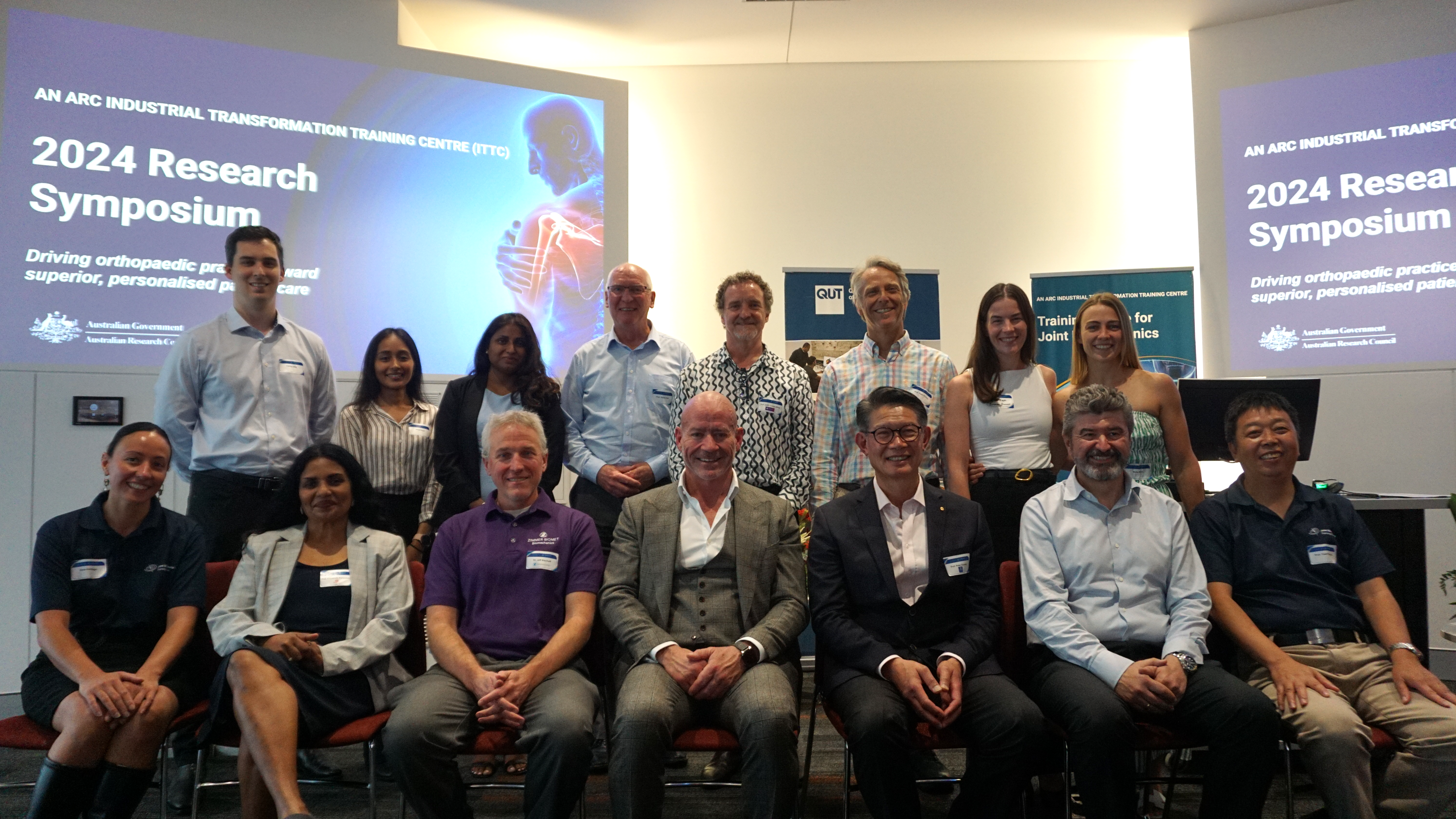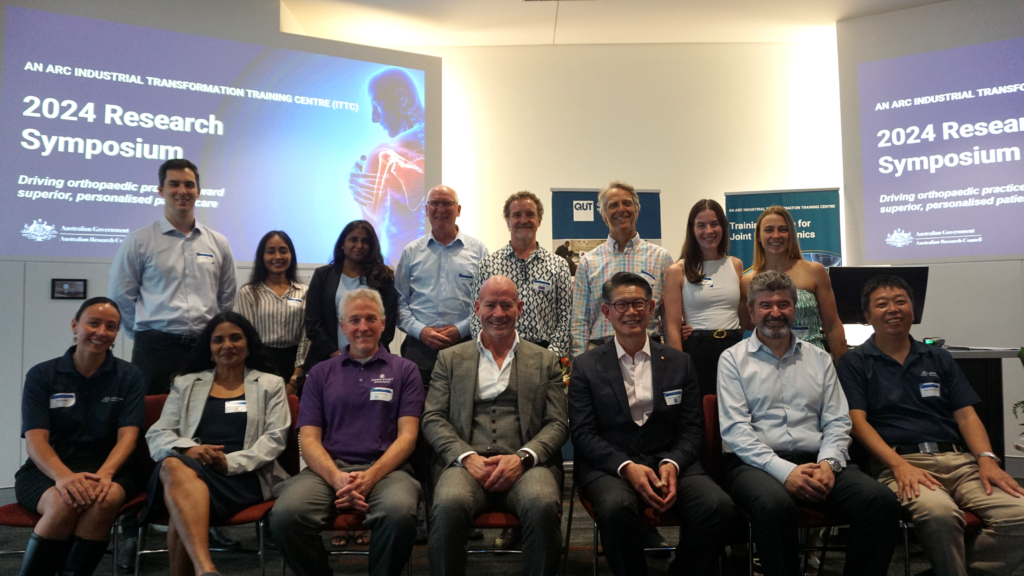
Tuesday 10 Dec 2024
The ARC Training Centre for Joint Biomechanics/QUASR Annual Research Symposium held at Queensland University of Technology (QUT) brought together leading experts, researchers, and industry partners to discuss the latest advancements in medical technology and clinical practice. The symposium’s theme, “Revolutionising MedTech & Clinical Practice: The Synergy of Biomechanics, Tissue Engineering and Medical Robotics,” set the stage for a day of insightful keynotes, panel discussions, and rapid-fire presentations.
The symposium officially commenced with a warm welcome from Prof. Glen Lichtwark, Head of the School of Exercise and Nutrition Science. Prof. Lichtwark set the tone for the day, emphasising the importance of interdisciplinary collaboration in driving innovation and improving patient outcomes.
The first session included a keynote by Adj. Prof. Kenneth Cutbush, who presented on “Revisiting Clinical Challenges: Enhancing Orthopaedic Outcomes through Biomechanics, Medical Robotics, and Tissue Engineering.” This was followed by a patient panel featuring Dr. John Taske and E/Prof. Paul Burnett, who shared their personal experiences and perspectives on advancements in orthopaedic care.
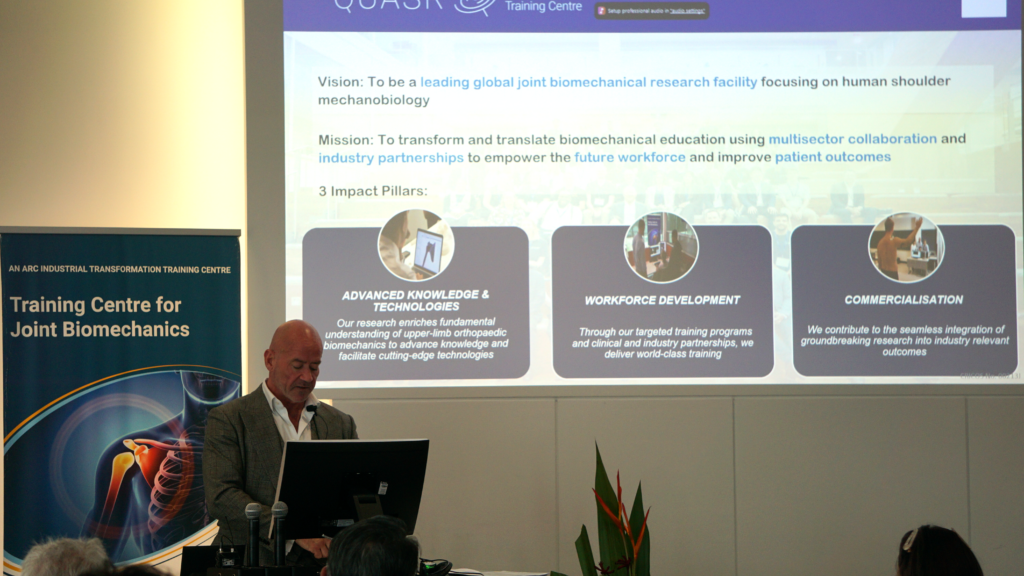
ADJ. Prof. ken cutbush (Orthopaedic surgeon, ken cutbush clinic, St andrew's war memorial hospital)
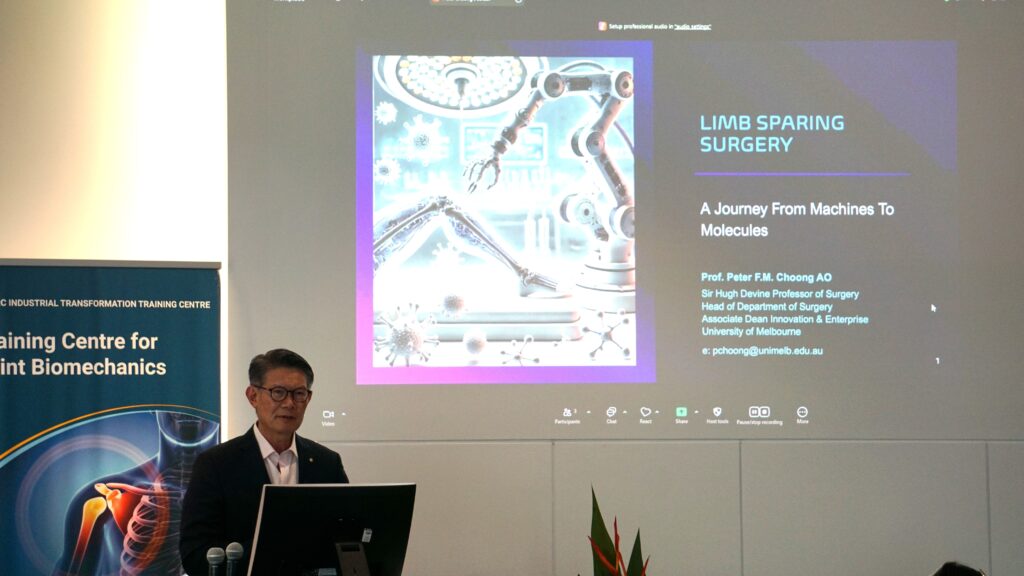
Prof. Peter Choong (St Vincent'S Private Hospital/ UNi melB)
Prof. Peter Choong, a prominent leader in orthopaedic surgery and biomedical engineering, delivered the second keynote of the day, titled “Limb Sparing Surgery: A Journey from Machines to Molecules.” As the Head of the Department of Surgery at the University of Melbourne and Director of Orthopaedics at St Vincent’s Hospital, Prof. Choong’s expertise in joint replacement and innovative implant designs is unparalleled. His dedication to advancing orthopaedic care and education has made him a respected figure in both clinical and academic circles. “Failure helps us see how we can be better next time,” Prof. Choong emphasized, highlighting the importance of a holistic approach to medicine.
The MedTech panel, moderated by Prof. Justin Cooper-White from the University of Queensland, delved into the overarching theme of the day, “Revolutionising MedTech & Clinical Practice: The Synergy of Biomechanics, Tissue Engineering and Medical Robotics.” The panel featured esteemed experts including Prof. Peter Choong, Prof. Saso Ivanovski (Head of School of Dentistry, UQ), Prof. Chamindie Punyadeera (Science and Health, Griffith University), Dr. Jeff Bischoff (Senior Director of Biomechanics Research, Zimmer Biomet US) and A/Prof. Nathalie Bock (Bone & Tumour Bioengineering Research Group Lead, QUT). They discussed the impact of their work and fundamental research on patient outcomes. Dr. Jeff Bischoff reminded us, “We owe it to the patients to ensure that the tech we create has a clear and positive effect on outcomes.”
After a networking lunch, the symposium resumed with rapid-fire presentations from various research programs. Higher Degree Researchers and Postdoctoral Fellows from the four research programs within the training centre shared their research achievements from the past year.
Program 1 Rapid Fires
- Dr. Bart Bolsterlee (research by Yilan Zhang): “Diffusion Tensor Imaging for Reconstruction and Measurement of Rotator Cuff Muscle Architecture”
- Dr. Natalia Mühl Castoldi: “The Power of Parathyroid Hormone (PTH) and Mechanics in Bone Formation”
François Bruyer-Montéléone: “Humeral Version Angle Estimates: Leveraging Statistical Shape and Pose Models”
Amine Lagzouli: “Automated 4D Tracking of Cortical Bone Remodeling Events in the Rabbit Using Synchrotron Micro-CT Scans”
Hamid Reza Jarrah: “Finite Element Predictions of Graft Stability in the Latarjet Procedure”
Dr. Max Lavaill: “AQ Industry Research Fellowship – Validation of a Shoulder Musculoskeletal Model”
Corinna Modiz: “Mathematical Modelling of Mineralization Patterns Across Trabecular and Cortical Bone”
Dr. Laith Alzubaidi (with Haider Alwzwazy): “FracNet: End-to-End Deep Learning Framework for Accurate Fracture Detection”
PROGRAM 2 RAPID FIRES
- Prof. Michael Milford (research by Morgan Windsor): “Predicting Failure, Now and Into the Future: A Surgical Robotics Case Study”
- Ahmed Sewify: “Towards Ultrasound Precision Tracking of the Shoulder Joint: A Simulation and Experimental Study”
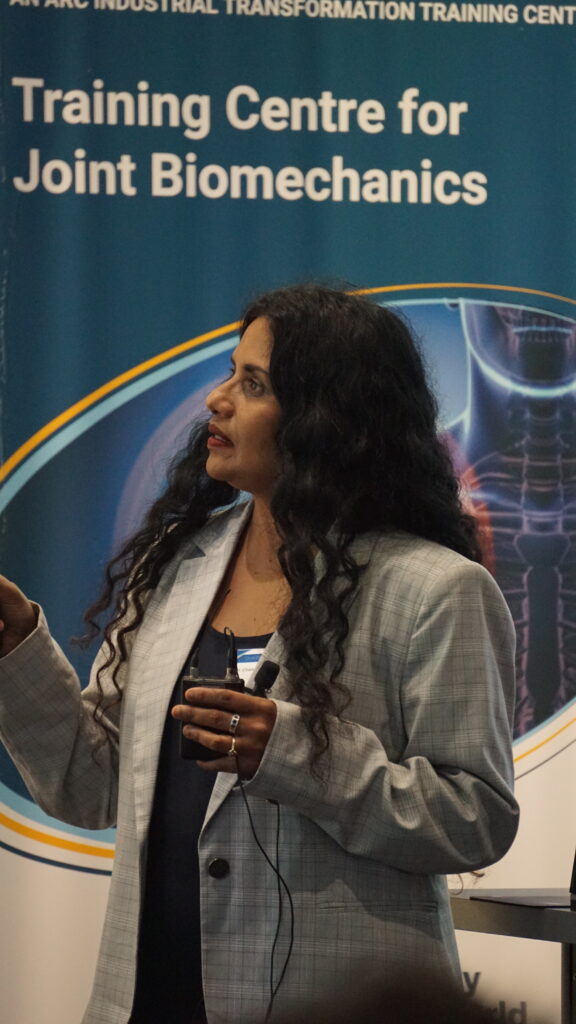
Prof. Chamindie Punyadeera (Griffith University)
Following a brief afternoon tea break, the symposium continued with a presentation by Prof. Chamindie Punyadeera on “Democratising Healthcare Access through Salivary Diagnostics.” With a career spanning both industry and academia, Prof. Punyadeera holds a joint appointment in Science and Health at Griffith University and leads the salivary diagnostics and liquid biopsy laboratory. Her groundbreaking work focuses on developing and commercialising biomarkers for heart failure and cancer. By validating these biomarkers, her research aims to stratify patients by disease risk and treatment response, accelerating personalised healthcare solutions. “It is a multidisciplinary, collaborative approach that takes our research to clinical practice,” Prof. Punyadeera emphasised, showcasing the power of teamwork in driving innovation.
Prof. Punyadeera’s presentation underscored the importance of multidisciplinary collaboration in research, linking the significance of our research centre’s four programs. This seamlessly led into the rapid-fire presentations from Programs 3 and 4, which focused on tissue engineering and in-vivo joint assessments, showcasing the diverse range of research completed within our centre.
PROGRAM 3 RAPID FIRES
- Asawari Parulekar: “Development of A Human iPSC-Based Model for Understanding Tendon Regeneration In Vitro”
- Sepideh Shemshad: “Modulation of Tendon Response Factors to Mechanical Underloading Through a Delivery System”
PROGRAM 4 RAPID FIRES
- Dr. Eric Su: “Does a Single Wearable Sensor Inform Clinically Relevant Information on Shoulder Instability and Function?”
- Dr. Wolbert van den Hoorn: “The Distribution of Neural Drives to Deltoid Segments”
- Amy Ma: “The Neuromuscular Control of the Shoulder Muscles in Healthy Individuals”
- Arthur Fabre: “Exploring Kinematic Mechanisms Underpinning Upper Limb and Shoulder Functions: an Inertial Measurement Unit-Based System Approach”
- Giacomo Nardese: “Neurophysiological Adaptation to Shoulder Pain: Corticomotor Features of Shoulder Muscles and Motor Control Implications”
- Anna Moyle: “Shoulder Kinematics and Muscle function pre- and post- Reverse Shoulder Arthroplasty (RSA)”
The day concluded with an awards ceremony, recognising outstanding contributions to research and innovation, followed by networking drinks and canapés. The awards were presented by Prof. Justin Cooper-White and Prof. YuanTong Gu, celebrating achievements in various categories such as Engagement/Collaboration, Best Team Player, Research Excellence, Outstanding Mentorship, and more.
award winners
- Engagement/Collaboration Award: Prof. Peter Pivonka
- Best Team Player Award: Rosa Armitage
- Research Excellence Award: Dr. Laith Alzubaidi
- Outstanding Mentorship Award: Dr. Natalia Mühl Castoldi
- Outstanding Industry Collaborator Award: Materialise – Ms. Monica Russell
- Director’s HDR Award: Best Centre Citizen: François Bruyer-Montéléone
- Director’s HDR Award: Best Research Performance: Morgan Windsor (Winner) and Amy Ma (Special Mention)
Since its establishment in 2020, the Training Centre for joint biomechanics has made significant strides in addressing the original clinical challenges and aims established at its inception, under the four program pillars. The event celebrated the progress made over the past four years across all research areas including computer modelling and simulation, robot-assisted testing and surgery, tissue-engineered scaffolds and in-vivo joint assessment.
Prof. Peter Choong’s quote, “if you aren’t communicating your activities [and research], you aren’t making an impact,” resonated throughout the symposium. The symposium successfully showcased the centre’s journey from 2020 to now, demonstrating how interdisciplinary collaboration and innovation have driven significant advancements in orthopaedic care. Our event today cerrtainly has been impactful, inspiring future research leaders to bridge the gap between academia and industry.
quotes
“Biomechanics is a newer science, and I’ll be fascinated to see where it goes in the next few years” – John Taske
“Failure helps us see how we can be better next time” – Prof. Peter Choong
“It is a multidisciplinary, collaborative approach that takes our research to clinical practice” – Prof. Chamindie Punyadeera
[paraphrased]: “Many implants fail independently of the surgeon and the implant itself – we have to approach medicine holistically – Prof. Peter Choong
“We owe it to the patients to ensure that the tech we create has a clear and positive effect on outcomes” – Dr. Jeff Bischoff
